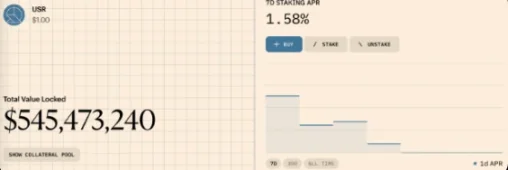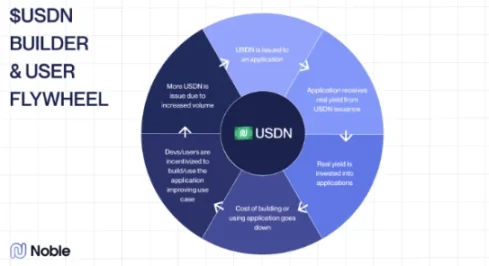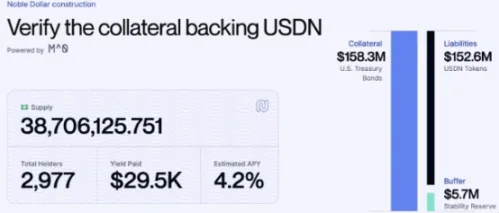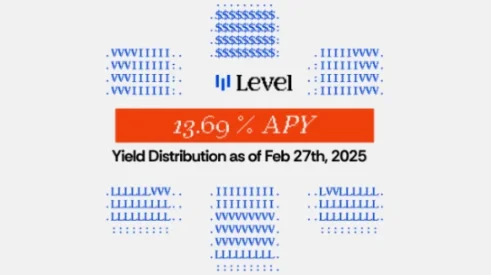Author: Marco Manoppo
Translation: Golem, Odaily Planet Daily
Four upcoming TGE yield-generating stablecoin protocols: Who can define the new paradigm of DeFi? (Including points program introduction)
Before USDC and USDT truly integrated with CEX and DEX, we had to gain delta-neutral risk exposure on BitMEX by shorting 1x BTC futures. This was essentially the most capital-efficient way to "earn neutral returns" at that time, without the need to repeatedly transfer funds between CEXs.
But those days are long gone; stablecoins have become a safe haven in the crypto market, providing a way to hold capital without relative volatility. Stablecoins have gradually dominated trading pairs in the crypto market, with pairs like XXX/ETH and XXX/BTC becoming less common unless you are an experienced trader betting in a specific direction.
These stablecoins have managed to convince so many users (around $100 billion in assets) to forgo yield in exchange for quick digital dollar exposure. In hindsight, it was easier to forgo yield when interest rates were 2% or lower, but everything changed after the interest rate hikes due to the COVID-19 pandemic.
Aside from being an excellent tool for transferring value, traditional (first-generation) stablecoins have little other utility. A new wave of stablecoin projects is changing this status quo.
Imagine if the dollars you hold could automatically work for you, earning returns from reserves, market making, re-staking, lending, and even AI-driven infrastructure.
The first version of stablecoins was purely backed by U.S. Treasury bills (like ONDO, Mountain, etc.), then Ethena introduced a yield-generating stablecoin backed by underlying trades. Today, new stablecoin protocols are continuously innovating in terms of yield sources and distribution, providing users with a better experience.
Next-generation stablecoins are not just sitting in users' wallets; they can generate returns in ways that were once only accessible to hedge funds, market makers, and institutional participants. From DeFi-native lending pools to AI-driven financial networks, these yield-generating stablecoins are unlocking a new form of passive income (with certain risks).
We are in a bear market for altcoins, and seeking higher yields in a more stable environment has become a mainstream demand. This article will introduce four yield-generating stablecoin protocols that may soon have their TGE.
CAP (cUSD)

CAP is a new stablecoin protocol built on MegaETH that allows users to earn actual returns without relying on common DeFi tricks (like token issuance). Instead, it leverages external yield sources such as market making, MEV, and arbitrage, which are methods that "big players" have profited from in the market for years.
The key attraction is that everyday users can now enjoy the same money-making strategies without needing internal contacts or a certain level of financial knowledge. cUSD (the stablecoin of CAP) is backed 1:1 by USDC/USDT, meaning it is fully collateralized and always redeemable.
Unlike other yield-stablecoins that rely on DeFi liquidity incentives, CAP transfers risk to re-stakers (those who stake ETH through EigenLayer to protect the protocol).
cUSD has two versions:
- Interest-bearing: Earn passive income from proxy strategies.
- Non-interest-bearing: Pegged to the dollar, making it easier to use in DeFi.
CAP will also launch stablecoins pegged to BTC and ETH, allowing users to choose different assets while still earning returns.
Key Statistics
Not reliant on token issuance
Most DeFi protocols rely on token issuance to attract liquidity, but this model is unsustainable. The top 5 DEXs in the market issue about $462 million annually just to maintain liquidity provider participation.
Many stablecoins depend on these incentives to maintain their peg or generate yield, but this creates a flywheel problem where liquidity disappears when issuance runs dry.
CAP does not rely on token incentives; instead, it derives actual returns from external sources like MEV, arbitrage, and RWA. This makes CAP's stablecoin more scalable and resilient, avoiding the liquidity drain that plagues many incentive-driven protocols. Users can earn returns without relying on new token issuance, making it sustainable under any market conditions.
Market Making, MEV, and RWA
Last year, market making revenue in the overall market exceeded $2 billion. MEV profits on Ethereum alone reached $686 million. Most stablecoins overlook corporate bonds, a $40 trillion market. While some stablecoins use U.S. Treasury bills, they rely on centralized custodians.
CAP does not depend on TradFi intermediaries; instead, it combines RWA yield streams with crypto-native strategies like MEV and arbitrage. Operators can deploy capital into bonds, RWA, and structured yield products, while re-stakers provide risk coverage.
This approach offers higher and more stable returns without relying on unsustainable DeFi incentives—linking traditional finance with DeFi.
Points and Airdrop Program
CAP currently does not have a clear points system.
Resolv (USR)

Resolv is the stablecoin protocol issuing USR, which is pegged to the dollar. Unlike traditional stablecoins backed by fiat reserves or Treasury bills, Resolv keeps its system on-chain while hedging ETH price volatility through perpetual futures. USR is 100% backed by ETH and is over-collateralized through an insurance layer called RLP (Resolv Liquidity Pool). Key features include:
- ETH-backed: The protocol holds ETH collateral and hedges price risk through short-term futures;
- On-chain staking: Most ETH is staked to generate yield;
- Institutional custody: A portion is held as margin for futures trading.
Key Statistics

- Total Locked Value (TVL): $545 million
- stUSR Yield (APR): ~2%
- RLP Yield (APR): ~1.5%
- New Yield Source: Lagoon Finance provides ~11% base APR for WETH deposits
Yield and Profit Distribution
Users can stake USR (stUSR) to earn rewards, while RLP holders receive additional risk-based premiums. Profits come from ETH staking rewards, futures positions, and protocol fees (0.05% for instant redemptions). If the protocol incurs losses, they are absorbed by RLP holders, ensuring the stablecoin is fully supported.
Points and Airdrop Program
Resolv has a points system that rewards users based on their activities, with different point rewards for various activities:
- Basic Rate: Earn 15 points per day for every 1 USR;
- Epoch Boost: Early adopters can earn an additional 150% points, totaling 37.5 points per day for each USR;
- Extra Boost: Users can earn more points through various activities, with details available on Resolv's social media channels.
Project Latest Updates and Integrations
- Instant Redemption Enabled: Now available for whitelisted users, with a daily limit of 1 million USR.
- Become a member of the Super State Industrial Council: Strengthening the connection between TradFi and DeFi.
- Binance Wallet Integration: Simplifying access to Resolv.
Noble (USDN)

Noble issues USDN, a stablecoin that generates yield simply by holding it. USDN is fully backed by short-term U.S. Treasury bills, providing real-world returns without the need to stake or lock anything, ensuring the safety of user funds. Key features include:
- USDN is 100% backed by U.S. Treasury bills through the M^0 protocol;
- Fully supported by U.S. Treasury bills—no algorithmic support or risk assets;
- Asset managers hold audited and verified collateral;
- No restrictions, allowing users to buy, sell, transfer, or redeem USDN at any time.
Key Statistics

- Total Supply: 37.7 million
- Total Holders: 2,972
- Collateral (U.S. Treasury): $158.3 million
- Liabilities (Outstanding USDN): $152.6 million
- Reserve Buffer: $5.7 million
- Estimated APY: 4.2% (paid daily)
- Total Yield Paid (Daily): $3,216.41
Points and Airdrop Program
The basic APY for USDN is 4.2% (accumulated from the moment of holding USDN), and Noble rewards holders who deposit USDN into the points vault with points.
Every 100 USDN earns 1 point daily, with multipliers increasing based on the holding period:
- 30-59 days: x 1
- 60-89 days: x 1.25
- 90-119 days: x 1.5
- 120+ days: x 1.75
Additional rewards are available when USDN's total locked value (TVL) reaches milestones of $10 million, $50 million, and $100 million.
Project Latest Updates and Integrations
- USDN StableSwap launched—supporting native exchanges between stable assets.
- Cross-chain transfer—USDN fully achieves multi-chain through Wormhole NTT.
- Audited and transparent—backed by top security firms.
Level (lvlUSD)

Level is a decentralized stablecoin protocol that issues lvlUSD, fully backed by USDC and USDT. Unlike traditional stablecoins, lvlUSD generates DeFi-native yields by providing collateral to lending protocols like Aave and Morpho. These yields are returned to users, making lvlUSD a yield stablecoin seamlessly integrated into DeFi. Key features include:
- lvlUSD is 100% backed by USDC and USDT, with reserves deployed to blue-chip DeFi lending protocols to generate yields;
- Lending yields: USDC and USDT are deposited into lending markets like Aave and Morpho;
- Re-staking rewards: Some lending receipt tokens (like aUSDC) are re-staked in Symbiotic for additional rewards;
- Complete on-chain transparency: Users can verify reserves at any time.
Points and Airdrop Program (Level XP)
Stake lvlUSD to earn slvlUSD, which automatically accumulates yields. At the same time, Level offers Level XP, a points reward system for active users. Ways to earn XP include:
- Depositing lvlUSD in the XP farm
- Holding Pendle, Spectra, or Curve LP tokens
- Using lvlUSD as collateral on Morpho
Multiplier system:
- LP or YT tokens earn 40x XP
- slvlUSD earns 20x XP
- lvlUSD earns 10x XP
- Bonus XP from partner protocols: Users can earn additional points from protocols like Resolv, Frax, Elixir, and Angle.
Project Recent Updates and Integrations
- Expanding lending yield sources—more protocols beyond Aave are coming soon.
- Re-staking integration—lvlUSD yields are enhanced through re-staking in Symbiotic.
- Cross-chain expansion—lvlUSD becomes more composable within the DeFi ecosystem.
The Future Path of Stablecoins
Frankly, most of the yields from these stablecoins do not necessarily come from new types of assets. Aside from possibly including MEV and hedge fund treasury strategies, most stablecoins are competing with established players using the same types of productive assets.
However, how stablecoin protocols can input new types of assets (both tangible and intangible) requires examining whether there is sufficient demand for on-chain native wealth. For example, we have seen some projects in the past attempt to generate yields through private credit or small business loans, but the results were not good. Heavy off-chain components hindered the protocol's ability to create an on-chain capital flywheel, and the demand from crypto-native whales was insufficient (non-crypto-native whales do not need on-chain avenues to gain these risk exposures).
Stablecoins still have a long way to go before becoming a safe store of value. Next-generation stablecoins aim to change the game by providing actual yields from so-called productive assets. As DeFi matures, yield-generating stablecoins will become core financial primitives, bridging the gap between cryptocurrencies and traditional finance.
However, it remains to be seen what other types of assets can elevate these yield-generating stablecoins to a new level. Perhaps we just need to scale up without introducing new types of assets; only time will tell us the answer.
免责声明:本文章仅代表作者个人观点,不代表本平台的立场和观点。本文章仅供信息分享,不构成对任何人的任何投资建议。用户与作者之间的任何争议,与本平台无关。如网页中刊载的文章或图片涉及侵权,请提供相关的权利证明和身份证明发送邮件到support@aicoin.com,本平台相关工作人员将会进行核查。




